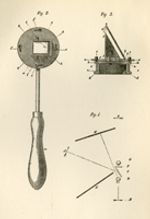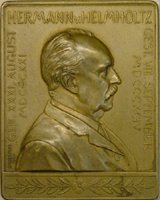 Hermann Ludwig Ferdinand von Helmholtz (1821-1894) introduced the ophthalmoscope on December 6, 1850 and revolutionized ophthalmology. The ophthalmoscope, the most important invention for ophthalmologist clinicians, is an instrument that allows the ophthalmologist to look inside a person’s eye and see the details of the living retina. Ophthalmoscopes allow physicians to diagnose eye diseases and prevent blindness.
Hermann Ludwig Ferdinand von Helmholtz (1821-1894) introduced the ophthalmoscope on December 6, 1850 and revolutionized ophthalmology. The ophthalmoscope, the most important invention for ophthalmologist clinicians, is an instrument that allows the ophthalmologist to look inside a person’s eye and see the details of the living retina. Ophthalmoscopes allow physicians to diagnose eye diseases and prevent blindness.
Helmholtz created the ophthalmoscope during the preparation of an experiment to demonstrate the law of conservation of energy. For the experiment, Helmholtz constructed a crude instrument made of cardboard, glue and microscope glass plates. Helmholtz’s instrument showed that light entering the pupil is reflected back to its source. Furthermore, the light follows the same path out of the eye as it took entering the pupil. Using his makeshift ophthalmoscope, Helmholtz could place his eye in the path of the rays of light entering and leaving the patient’s eye, thereby allowing the patient’s retina to be seen.
 Helmholtz was not the first person to look at the living retina or the first person to fashion a device for viewing it. Johannes Purkinje had made the discovery in 1823 and Charles Babbage had fashioned an ophthalmoscope similar to Helmholtz’s design in 1847. However, neither discovery was well known at the time. Helmholtz created his ophthalmoscope without the benefit of their knowledge and, unlike his predecessors, he publicized his findings.
Helmholtz was not the first person to look at the living retina or the first person to fashion a device for viewing it. Johannes Purkinje had made the discovery in 1823 and Charles Babbage had fashioned an ophthalmoscope similar to Helmholtz’s design in 1847. However, neither discovery was well known at the time. Helmholtz created his ophthalmoscope without the benefit of their knowledge and, unlike his predecessors, he publicized his findings.
By 1900, over 200 variations of the ophthalmoscope were being manufactured all over the world. Designers of scopes were most concerned with weight, durability and ease of use with one hand. The Museum of the Eye's collection contains hundreds of examples of these instruments from countries such as France, England, the United States and Japan.